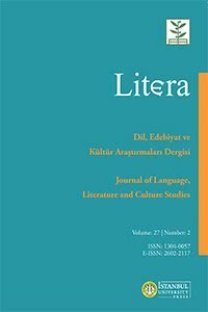Süreksiz Tarih ve Büyülü Gerçekçilik: Kazuo Ishiguro’nun Gömülü Dev Adlı Romanının Foucaultcu Bir Okuması
Kazuo Ishiguro, Gömülü Dev, büyülü gerçekçilik, tarih, süreksizlik
Discontinuous History and Magical Realism:A Foucauldian Reading of Kazuo Ishiguro’s The Buried Giant
Kazuo Ishiguro, The Buried Giant, magical realism, history, discontinuity,
___
Bhabha, H. (1990). Introduction: narrating the nation. In Homi Bhabha (Ed.), Nation and Narration (pp. 1-7). London: Routledge. google scholarCharlwood, C. (2018). National identities, personal crises: Amnesia in Kazuo Ishiguro’s the buried giant. Open CulturalStudies, 2, 25-38. https://doi.org/10.1515/culture-2018-0004 google scholar
D’haen, T. L. (1997). Postmodernisms: From fantastic to magic realist. In H. Bertens & D. Fokkema (Eds.) International postmodernism: Theory and literary practice (pp. 283-293). Amsterdam: John Benjamins Publishing. google scholar
Esen, Ö. (2018). pp. 7-20; Recovering memories and reconstructing realities: Magical realism and Kazuo Ishiguro’s The buried giant. (Master’s thesis, Pamukkale University). Retrieved from http://acikerisim.pau.edu.tr/xmlui/ bitstream/handle/11499/27617/%C3%96zg%C3%BCr%20Esen.pdf?sequence=1&isAllowed=y google scholar
Faris, W. B. (2004). Ordinary enchanments: Magical realism and the remystification of narrative. Nashville: Vanderbilt University Press. google scholar
Foucault, M. (1980). Power / knowledge: Selected interviews and other writings: 1972-1977. (C. Gordon, Ed.). New York: Pantheon Books. google scholar
------. (2001). Power: The essential works of Foucault, 1954-1984. (Vol. 3). (R. Hurley & J. D. Faubion & P. Rabinow, Eds.). New York: The New Press. google scholar
------. (2002). Archaeology of knowledge. (A. Sheridan, Trans.) London & New York: Routledge. google scholar
Frye, N. (2000). Anatomy of criticism: Four essays. Princeton & Oxford: Princeton University Press. google scholar
Gordon, C. (2001). Introduction. In R. Hurley & J. D. Faubion & P. Rabinow (Eds.), Power (The essential works of Foucault, 1954-1984 (pp. xi-xli). New York: The New Press. google scholar
Hart, S. M. (2005). Introduction: Globalization of Magical Realism: New Politics of Aesthetics. In S. M. Hart & W. Ouyang (Eds.), A companion to magical realism (pp. 1-12). Woodbridge: Tamesis. google scholar
Hutcheon, L. (1995). A poetics of postmodernism. London: Routledge. google scholar
Ishiguro, K. (2015). The buried giant. London: Faber. google scholar
------. (2016, July 1). Kazuo Ishiguro on his fears for Britain after Brexit. Financial Times. Retrieved from https:// www.ft.com/content/7877a0a6-3e11-11e6-9f2c-36b487ebd80a google scholar
------. (2017). Nobel lecture (pdf). Retrieved from https://www.nobelprize.org/uploads/2018/06/ishiguro-lecture_en-3.pdf google scholar
Lampert-Weissig, L. (2010). Medieval literature and postcolonial studies. Edinburgh: Edinburgh University Press. google scholar
Lynch, A. (2017). Post-colonial studies. In L. Tether and J. McFadyen (Eds.), Handbook of Arthurian romance: King Arthur’s court in medieval European literature (pp. 307-320). Berlin: De Gruyter. google scholar
Lupack, A. (2015). [Review of the buried giant]. Arthuriana, 25(3), 118-120. Retrieved from http://www.jstor.org/ stable/24643534 google scholar
Mills, S. (2003) Michel Foucault. London & New York: Routledge. google scholar
Munslow, A. (2006) Deconstructing history. 2nd Ed. London & New York: Routledge. google scholar
Pearsall, D. (2005). Arthurian romance: A short introduction. Oxford: Blackwell. google scholar
Poster, M. (1984). Foucault, Marxism and history: Mode of production versus mode of information. Oxford: Polity Press. google scholar
Shaw D. L. (2005). The presence of myth in Borges, Carpentier, Asturias, Rulfo and Garca Marquez. In S. M. Hart & W. Ouyang (Eds.), A companion to magical realism (pp. 46-54). Woodbridge: Tamesis. google scholar
Slemon, S. (1988). Magic realism as post-colonial discourse. Canadian Literature, 116, 9-24. Retrieved from https://canlit.ca/full-issue/?issue=116 google scholar
Sönmez Demir, Y. (2020) Kazuo Ishiguro’s postmodern hypertexts: Generic reconfigurations in the Remains of the day, when we were orphans, and the buried giant. (Doctoral dissertation, Middle East Technical University). Retrieved from http://etd.lib.metu.edu.tr/upload/12625819/index.pdf google scholar
Teo, Y. (2014). Kazuo Ishiguro and memory. New York: Palgrave Macmillan. google scholar
Tulving, E. (1972). Episodic and semantic memory. In E. Tulving & W. Donaldson (Eds.), Organization of memory (pp. 381-403). New York: Academic. google scholar
------. (1989). Memory: Performance, knowledge, and experience. European Journal of Cognitive Psychology, 1:1, 3-26. dx.doi.org/10.1080/09541448908403069 google scholar
Tutan, D. E. (2016). A hybrid discourse: From Latin American magic realism to the British postcolonial postmodern novel. Selçuk University The Journal of Institute of Social Sciences, 36, 38-50. Retrieved from http://dergisosyalbil.selcuk.edu.tr/susbed/article/view/1285/1079 google scholar
Vernon, M., & Miller, M.A. (2018). Navigating wonder: The medieval geographies of Kazuo Ishiguro’s the buried giant. Arthuriana 28(4), 68-89. doi:10.1353/art.2018.0036. google scholar
Zamora L. P. and W. B. Faris. (1995). Introduction. In L. P. Zamora & W. B. Faris (Eds.), Magical realism: Theory, history, community (pp. 1-11). Durham & London: Duke University Press. google scholar
- Yayın Aralığı: Yılda 2 Sayı
- Yayıncı: İstanbul Üniversitesi
Marfouq ASSIA, Abdelghani BRIJA
Reading Turcophilia: The Turkish Life of Pierre Loti in Aziyadé and Fantôme d’Orient
Representation of the French in Nourredine Saadi’s novel La Maison de lumière
Kent ve İnsan: 19.Yüzyılın İlk Yarısı Rus Edebiyatında Peterburg
Page Layout and Braiding in Hergé’s Seven Crystal Balls
Mario Vargas Llosa’nın Lituma en los Andes Adlı Romanında Anlatının Yapısı
Translating Money: The Role of Cognitive Complements in Literary Translation
Azteklerin Susturduğu Kadınların Mango Sokağı’ndaki Ev’den Yükselen Sesleri
Mythological Intertext in Maeterlinck’s Pelléas and Mélisande
Dmytro CHYSTİAK, Olena KOBCHİNSKA, Iurii MOSENKİS
Strolling and Self-quest in The Tribulations of the Last Sijilmassi by Fouad Laroui
